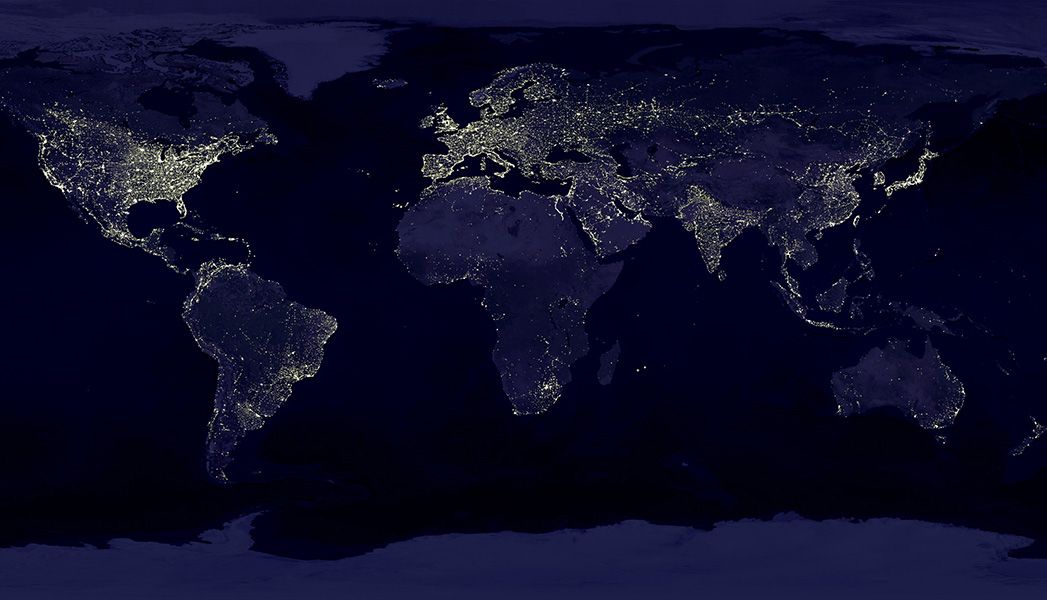The Potential Dark Side of Nobel-Winning LEDs: Pest Problems
The white lighting is clean and efficient but also a lot more attractive to flying invertebrates
/https://tf-cmsv2-smithsonianmag-media.s3.amazonaws.com/filer/8f/77/8f7770d2-6b37-4155-9031-2c588c0f821a/42-53023296.jpg)
Earlier this week, the Nobel Prize in Physics was awarded to three scientists who invented blue light-emitting diodes. The work was crucial for producing bright white LED lighting, which is more energy-efficient than traditional incandescent bulbs. But there's a possible downside to widespread use of LEDs: They could make light pollution worse.
The ease with which we can light up our world at night has transformed human civilization, but all that excess light can cause problems for wildlife—especially nocturnal creatures. The amount and direction of light aren’t the only problems. The various wavelengths of light emitted by lamps can affect animals differently.
For decades streetlights have generally used yellow, high-pressure sodium vapor lamps, which light up by sending an arc of electricity through vaporized sodium metal. The lamps are pretty efficient and powerful. The intense yellow color they emit isn’t all that attractive, though, which is why these lights have been restricted to use outdoors. Now, white LEDs are quickly replacing the sodium lamps, but a study published in the October issue of Ecological Applications shows why that might be an environmental problem.
“The main driver of the ecological impacts that result from a shift to white LED lighting will be the increase in emissions of short wavelength ‘blue’ light,” Stephen Pawson, an entomologist at the New Zealand research institute Scion, said in an email. “The behavior of many animals is influenced by light in the blue portion of the spectrum. For example, insects have specific photoreceptors for blue light. Thus large-scale adoption of ‘white’ lighting is likely to increase the impacts of nighttime lighting on all species sensitive to ‘blue’ light.”

Industrial white LEDs actually start with a blue LED that is covered with a phosphor coating, which absorbs some of the short-wavelength blue light and reemits it in longer wavelengths. This combination of short and long wavelengths makes the light appear white to human eyes. In the study, Pawson and his Scion colleague Martin Bader looked at the effects of industrial white LEDs versus sodium lamps on insects. They set out the lamps in a field at night, placing sheets of a sticky material next to the lights to catch any insects that came near.
On average, the white LEDs attracted 48 percent more flying invertebrates than the sodium lamps. Pawson and Bader tested six white LEDs that differed in the amount of blue light emitted. The researchers hypothesized that certain white LEDs might be less attractive to invertebrates than others. Unfortunately, that wasn’t the case.
“We could not reduce the ecological affects by modifying the [LEDs] because each of them still emitted enough ‘blue’ light to have an effect,” Pawson said in an email. He is now looking at filters to see if removing more of the blue wavelengths will make the lights less attractive to insects.
If installed as currently designed, white LEDs could exacerbate pest problems, Pawson and Bader note in their study. Midge swarms, for instance, are already known to be more attracted to white lighting. The study also highlights the importance of location when deciding on lighting. The researchers point out that gypsy moths, an invasive pest species, are also attracted to white light, so installing white LEDs near an active port, for instance, could increase the risk that the moths would lay eggs on a boat and end up invading a new region of the world.
/https://tf-cmsv2-smithsonianmag-media.s3.amazonaws.com/accounts/headshot/Sarah-Zielinski-240.jpg)
/https://tf-cmsv2-smithsonianmag-media.s3.amazonaws.com/accounts/headshot/Sarah-Zielinski-240.jpg)